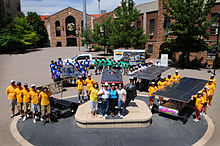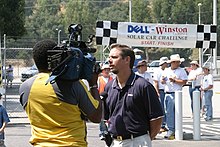This article has multiple issues. Please help improve it or discuss these issues on the talk page. (Learn how and when to remove these messages)
|
Motor race
| Solar Car Challenge | |
|---|---|
| Venue | Texas Motor Speedway |
| Location | United States |
| Corporate sponsor | Lockheed Martin Corporation |
| First race | 1995 |
| Last race | 2024 |
| Duration | 4-7 days |
The Solar Car Challenge is an annual solar-powered car race for high school students. The event attracts teams from around the world, but mostly from American high schools. The race was first held in 1995. Each event is the end product of a two-year education cycle launched by the Winston Solar Car Team. On odd-numbered years, the race is a road course that starts at the Texas Motor Speedway, Fort Worth, Texas; the end of the course varies from year to year. On even-numbered years, the race is a track race around the Texas Motor Speedway. Dell sponsored the event from 2002-2008. Hunt Oil Company sponsored the 2010 race. Oncor sponsored the 2024 race.
History

The Solar Car Challenge is an educational program aimed at engaging high school students in designing, building, and racing solar-powered vehicles. Established in 1989, the challenge promotes science, engineering, technology, and green energy solutions among youth.
Education Program and Objectives
In 1993, the Solar Car Team expanded its efforts with the introduction of the Solar Education Program. This initiative teaches students how to construct roadworthy solar cars through curriculum materials, on-site visits, workshops, and virtual learning opportunities. The program's primary objective is to inspire students by applying scientific principles to real-world challenges.
Racing Events and Format
The Solar Car Challenge features two main types of events:

- Closed-Track Races: Held at the Texas Motor Speedway, these events emphasize performance and technical innovation in a controlled environment.
- Cross-Country Races: Spanning various distances across the United States, these races test both the endurance and efficiency of solar cars over long distances.
Participants prioritize collaboration over competition, reflecting the ethos known as "The Spirit of Solar Car Racing." Outstanding team members are recognized annually through the prestigious Marx Award.
Divisions and Technological Advancements
Per the 2023 race rules, teams compete in several divisions, each offering different technological opportunities and challenges:
- Classic Division (including Advanced Classic Division): Retains all rules and regulations specified in the Official Rules. No hub motors are permitted. Solar modules (either individual cells or panels) must have a rated efficiency of 22% or below. Prefabricated solar panels are rated per overall panel efficiency, while solar cells are rated per individual cell efficiency. Schools entering the Classic Division for three or more years must compete in the Advanced Classic Division, which maintains all rules and regulations of the Classic Division.
- Advanced Division: Provides teams with the opportunity to explore new and upcoming technology for their solar car. In addition to the rules and regulations set out in the Official Rules, teams may use hub motors, solar cells with a rated efficiency above 22%, prefabricated solar car molds, and other battery types. The list price for all bare solar cells must be less than $10/watt, with the option to pay extra for cutting, tabbing, or lamination of cells. Prefabricated solar car molds refer to molds designed for solar cars that are not directly constructed by team members, with the body made by the team. Batteries may be of any chemistry type but must have appropriate protection systems required by that type.
- Electric-Solar Powered Car Division: Allows teams to build a two-seater electric vehicle powered by a stationary power station. This vehicle must meet all relevant requirements specified for a Classic Division car.
- Cruiser Division: Enables teams to construct a solar car resembling a regular passenger vehicle, capable of seating four, including the driver. Teams earn points based on the number of person-miles carried by the solar car. This vehicle must meet all relevant requirements specified for an Advanced Division car.
Event Logistics and Safety
Teams undergo a rigorous qualifying process known as "Scrutineering" to ensure compliance with safety and technical regulations. Each solar car is equipped with essential safety features including roll cages, safety harnesses, communication systems, and fire extinguishers. Support vehicles and trailers are also available during races to assist with technical issues and emergencies.
Impact and Outreach
The Solar Car Challenge Foundation, recognized as a 501(c)(3) non-profit educational organization, has expanded its global outreach. Workshops, curriculum materials, DVDs, and on-site visits have introduced the challenge to over 1100 schools across 20 countries. This initiative continues to inspire the next generation of innovators in renewable energy technology.

The 2007 The Solar Car Challenge was featured on CNN affiliate KLTV.
| This section needs expansion. You can help by adding to it. (June 2008) |
The Solar Car Challenge was named one of America's 10 most innovative education programs by Business Wire in 2003.
See also
- Solar car racing
- World Solar Car Challenge
- The Quiet Achiever, the world's first solar-powered racecar
External links
References
| This article needs additional citations for verification. Please help improve this article by adding citations to reliable sources. Unsourced material may be challenged and removed. Find sources: "Solar Car Challenge" – news · newspapers · books · scholar · JSTOR (August 2007) (Learn how and when to remove this message) |
- "About the Solar Car Challenge". Solar Car Challenge (official website). Retrieved August 6, 2007.
- "2023 Solar Car Challenge Event Rules" (PDF). Archived from the original (PDF) on September 26, 2022.
- Tracy Watler (reporter) (July 18, 2007). Racing on solar power (Flash) (television report). KLTV/CNN.
| Photovoltaics | |||||||||||
|---|---|---|---|---|---|---|---|---|---|---|---|
| Concepts | |||||||||||
| Photovoltaic system | |||||||||||
| Applications |
| ||||||||||
| Generation systems |
| ||||||||||
| PV companies |
| ||||||||||